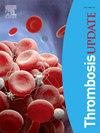Multimorbidity is associated with risk of incident venous thromboembolism – A nationwide proof-of-concept study
Q4 Medicine
引用次数: 0
Abstract
Background
Multimorbidity, i.e. two or more non-communicable diseases (NCDs), has been associated with venous thromboembolism (VTE), but whether multimorbidity is a predictor for incident VTE is unknown.
Aims
To examine the associations between multimorbidity and its severity with risk of incident VTE, and examine the association between nine different disease clusters and incident VTE.
Methods
A cohort study using landmark analysis of 2,694,442 individuals. Swedish national registers were linked and three landmarks (L1, L2, L3), i.e. baselines, were created with 14-, nine- and four-year follow-up times, respectively. Two or more NCDs defined multimorbidity and ≥5 marked multimorbidity severity. A hazard ratio (HR) with 95 % confidence interval (CI) for VTE was calculated and adjusted for sex, education and year of birth. Death and emigration were treated as competing events.
Results
A total of 2,694,442 individuals were included. Multimorbidity was associated with incident VTE in all three analyzed landmarks: adjusted HR for VTE was 2.47 (95%CI 2.24–2.72) for L1, HR was 2.23 (95%CI 2.11–2.36) for L2, and HR was 2.16 (95%CI 2.03–2.29) for L3. HR increased with multimorbidity severity. For instance, HRs for multimorbidity with five or more NCDs was 4.29 (95%CI 2.53–7.28) in L1 analysis, 4.45 (95%CI 3.64–5.45) in L2 analysis and 4.83 (95%CI 4.20–5.55) in L3 analysis. Moreover, seven of nine different multimorbidity disease clusters were predictors for VTE.
Conclusion
This study demonstrated proof-of-concept that multimorbidity is a novel dose-graded predictor for VTE. Further studies will determine the usefulness of multimorbidity for VTE prediction in different clinical settings.
多病与静脉血栓栓塞风险相关——一项全国性的概念验证研究
背景:多发病,即两种或两种以上的非传染性疾病(ncd),与静脉血栓栓塞(VTE)有关,但多发病是否是静脉血栓栓塞的预测因素尚不清楚。目的探讨多发病及其严重程度与静脉血栓栓塞发生风险之间的关系,以及9种不同疾病群与静脉血栓栓塞发生之间的关系。方法采用里程碑式分析的队列研究,纳入26694442例个体。瑞典国家登记册被联系起来,三个里程碑(L1, L2, L3),即基线,分别在14年,9年和4年的随访时间内被创建。两种或两种以上的非传染性疾病定义为多病,≥5种标记为多病严重程度。计算VTE的风险比(HR), 95%置信区间(CI),并根据性别、教育程度和出生年份进行调整。死亡和移民被视为相互竞争的事件。结果共纳入受试者2,694,442人。在所有三个分析的标志中,多重发病率与VTE事件相关:L1的VTE调整HR为2.47 (95%CI 2.24-2.72), L2的HR为2.23 (95%CI 2.11-2.36), L3的HR为2.16 (95%CI 2.03-2.29)。HR随着多病严重程度的增加而增加。例如,多病合并5种或以上非传染性疾病的hr在L1分析中为4.29 (95%CI 2.53-7.28),在L2分析中为4.45 (95%CI 3.64-5.45),在L3分析中为4.83 (95%CI 4.20-5.55)。此外,9种不同的多病性疾病群中有7种是静脉血栓栓塞的预测因子。结论:该研究证明了多重发病率是静脉血栓栓塞的一种新的剂量分级预测因子。进一步的研究将确定在不同的临床环境中多病性对静脉血栓栓塞预测的有用性。
本文章由计算机程序翻译,如有差异,请以英文原文为准。
求助全文
约1分钟内获得全文
求助全文

 求助内容:
求助内容: 应助结果提醒方式:
应助结果提醒方式:


